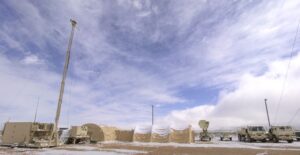
Northrop Grumman [NOC] said Thursday the Army has conducted two recent successful flight tests with its Integrated Air and Missile Defense Battle Command System (IBCS), one that involved intercepting a high-speed tactical ballistic missile and another where two cruise missile targets were taken out “in a stressing electronic attack environment.” The two flight tests were conducted this past week at White Sands Missile Range in New Mexico as part of the initial operational test and evaluation (IOT&E) for IBCS, with…

 By
By 











